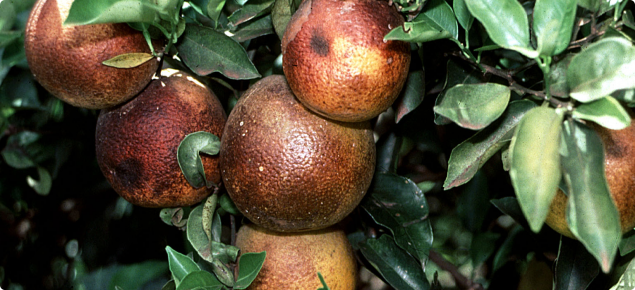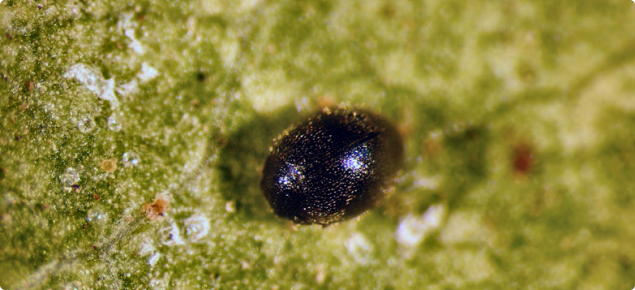Damage
Mites cause damage by sucking the cell contents from buds, leaves and fruit. On leaves, feeding damage results in stippling (light dots) which can sometimes take on a bronze color. Mites generally prefer to feed on young, flushing leaves, but if infestations are severe, they will also feed on older leaves. Leaf drop can occur through mite feeding and although this does not usually result in yield loss during the year of infestation (unless it occurs in spring or early summer), it can impact on the following year’s crop.
Symptoms of mite damage to fruit vary. Rust mites 'bronze' the skin of mature oranges, while broad mite causes 'shark-skin' to form on limes and lemons. Bud mite damage can deform lemons.
Life cycle
A typical mite life cycle is shown above. Eggs are laid by the female and the newly hatched mite resembles a tiny adult. From the six-legged larval stage they undergo two eight-legged nymphal stages before becoming adults. Mites shed their skins as they grow, with the shed skin often found on the leaves and fruit.
Identification
Two-spotted mite
Tetranychus urticae
Distribution: Found throughout Western Australia due to presence on other hosts such as vegetables and ornamentals. Rarely a problem in citrus.
Varieties attacked: All.
Damage: Feeding causes chlorosis (loss of pigmentation) on leaves and brown spots on fruit. If infestation is heavy, webbing may also be seen on leaves and fruit.
Identification: Adult female 0.5mm long with a dark spot either side of the body; male smaller and narrower. Mites may also be reddish in colour.
Life cycle: 7-12 days in summer and 12-21 days in winter depending on temperature. In cold areas they over-winter as orange-red females.
Monitoring: Fortnightly from January to April. Check leaves and fruit for mites.
Action level: When 20% or more fruit and leaves are infested.
Citrus bud mite
Eriophyes sheldoni (Ewing)
Distribution: All citrus growing areas.
Damage: Tiny eriophyiid mites live in the flower and leaf buds. Feeding damage to developing fruit causes fruit deformation. Other signs include rosette-like growth of leaves and distortion of flowers.
Varieties attacked: Lemons are attacked more frequently than other varieties.
Identification: Microscopic mite (0.17mm in length), creamy colour and worm-like.
Life cycle: 10 days in summer; 20-30 days in winter. Females lay up to 50 eggs and 20 generations per year.
Monitoring: Difficult without a microscope or 20x lens since bud dissection is required to determine mite presence.
Action level: If reduction in populations is desired, treatments should be applied two to three months before the bloom that is to be protected. Control can be difficult as the mite is protected within the leaf or flower bud.
Broad mite
Polyphagotarsonemus latus (Banks)
Distribution: Rare in WA citrus but found on a range of crops such as vegetables (capsicum, ornamentals).
Damage: Silver-grey colour (‘shark-skin’) and can be rubbed off.
Varieties attacked: Lemon and limes most common. Young grapefruit, oranges and mandarins may also be damaged.
Identification: Small (0.2mm long), white-pale yellow. Males may carry larger immature females on their backs.
Life cycle: Four to 10 days depending on temperature; up to 20 to 30 generations a year under favourable conditions. Adults live for 5-13 days. Females can lay five eggs per day.
Monitoring: Fortnightly, fruit set through to harvest. Check for presence/absence of broad mite on five randomly selected fruit per tree.
Action level: 5% or more of fruit infested.
Oriental spider mite
Eutetranychus orientalis (Klein)
Distribution: Northern growing areas (Carnarvon, Kununurra).
Damage: Chlorosis (loss of pigmentation) on leaves. Chlorosis on fruit can occur under high mite populations. Leaf drop if trees are also water stressed.
Identification: These mites have long legs giving a spider-like appearance. The adult female is 0.5mm long, reddish-brown body with long, lighter coloured legs. The male is smaller, with longer legs and lighter in colour.
Life cycle: One generation may be completed in 10 days depending on temperature with 10 to 20 generations per year.
Varieties attacked: All citrus.
Monitoring: Check five randomly selected fruit or leaves per tree per fortnight when presence is suspected.
Action level: 20% or more of fruit or leaves infested. In Carnarvon levels above 20% have been recorded with no apparent damage to fruit.
Citrus rust mite
Phyllocoptruta oleivora (Ashmead)
Distribution: Very rare in Western Australia.
Damage: Usually first noticed as bronzing on skin of mature oranges, although bronzing of leaves and branches also occurs. Look for white cast-off skins on the leaf and fruit surface to confirm mite infestation.
Identification: Microscopic mite (0.15mm long), yellow and wedge-shaped. Only seen with a microscope or 20x lens.
Life cycle: One generation can be completed in six days at 30°C. Females live four to six weeks, laying 30 eggs in a lifetime.
Monitoring: Difficult without a microscope or 20x lens. Look for mites on young foliage; check five randomly selected fruit per tree from January to April.
Action level: 5-10% or more of young and old fruit are infested.
Other mites
Non-pest mites are often found in citrus. These include mites that feed on decaying animal and plant material including bark, leaves and fruit, as well as predatory mites (mites that feed on other mites).
Mites that feed on fungi are often transparent to opaque or off-white. Scavengers are off-white to pale pink, often with a pale transverse stripe. Predatory mites tend to be fast moving and often bright red.
If in doubt of your identification, or you think you have found a different species of pest mite to that depicted here, have the specimens identified. Contact your local Department of Agriculture and Food office for further details.
Control
Chemical
- Miticides or horticultural oils are effective at controlling most mites.
- Oils are compatible with an IPM program, though oils do kill some beneficial wasps and suppress beneficial mite populations. However, residues do not persist.
- Always check the label before spraying, as not all oils are registered for use in citrus.
Biological
- A range of naturally occurring predators attacks mites in Western Australia. These include predatory mites, mite-eating ladybirds and lacewing larvae.
- Mite-eating ladybirds (mostly Stethorus species) can be distinguished from other ladybirds by their small size (1-1.5mm long) and black colour. Both the adults and larvae are mite predators.
- The predatory mite Phytoseiulus persimilis feeds on two-spotted mite and is available commercially for release.
Acknowledgements
Thresholds used in this information were taken from Citrus pests and their natural enemies: integrated pest management in Australia, edited by D Smith, GA Beattie and RH Broadley, Queensland Department of Primary Industries, 1997.







